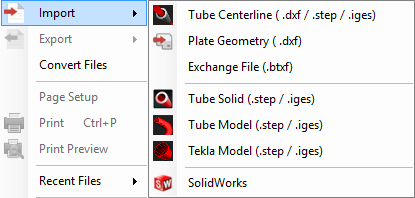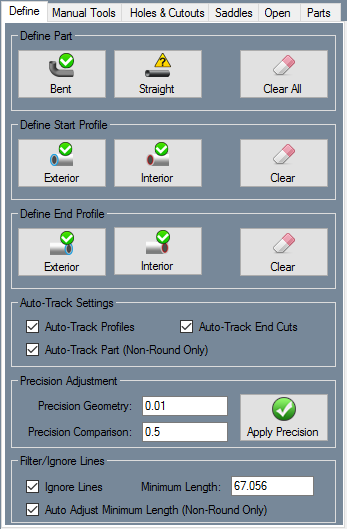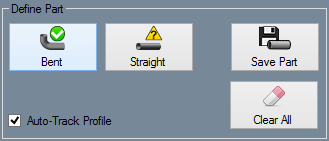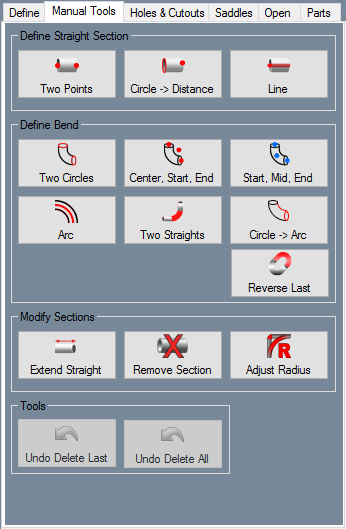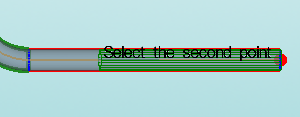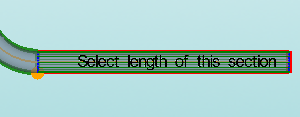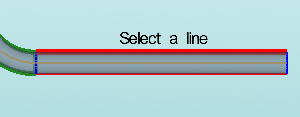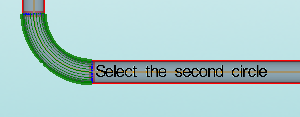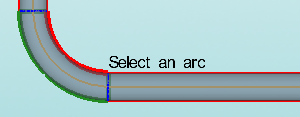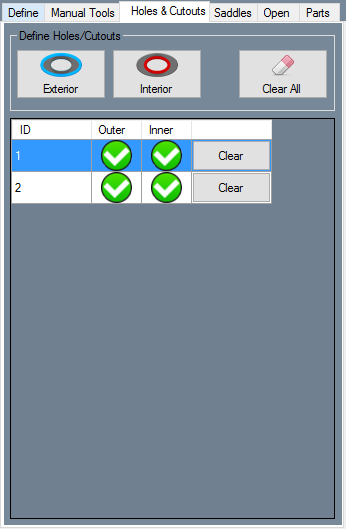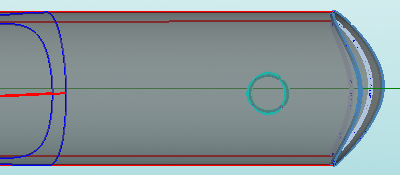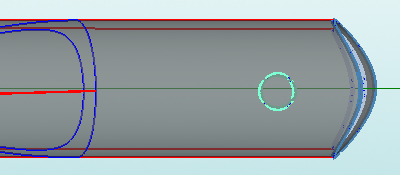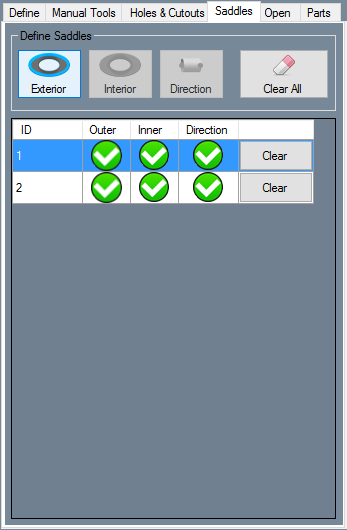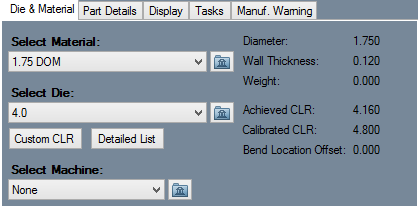Difference between revisions of "Industrial"
(→Die & Material) |
|||
| Line 217: | Line 217: | ||
===Die & Material=== | ===Die & Material=== | ||
| − | [[File:Die_&_Material_IND(2).png | + | [[File:Die_&_Material_IND(2).png|right]] |
*If you have not set defaults in the '''Options''' menu, you must select a material from the "'''Select Material'''" drop down menu. The corresponding '''Diameter''', '''Wall Thickness''' and '''Weight''' of the material will be shown to the right. | *If you have not set defaults in the '''Options''' menu, you must select a material from the "'''Select Material'''" drop down menu. The corresponding '''Diameter''', '''Wall Thickness''' and '''Weight''' of the material will be shown to the right. | ||
Revision as of 11:18, 15 September 2015
UNDER CONSTRUCTION: THANK YOU FOR YOUR PATIENCE.
"Bend-Tech Industrial comes equipped with all of the functionality available in our SE product along with the following."
Contents
Importing
"NOTE: All parts that are brought into Bend-Tech Industrial must be in either .STEP/.stp or .IGES/.igs format."
2. Choose a file to import by using the standard method. Go up to the File menu at the top left hand corner of the screen, select the Import option and choose from either Solid Model (.step/.stp), STEP (.step/.stp) or IGES (.IGES/.igs) from the list depending on which file format you'd like to import.
Defining The Part
Color Code
1. After importing a solid model, the part will appear with contoured lines, arcs and circles. These are color coded to help you to identify certain sections of the tubing.
- Yellow Lines: Indicate the centerline of the tubing.
- Blue Lines: Indicate the arcs and circles of the tubing.
- Red Lines: Indicate the straights within the length of tubing.
Material Definition
1. The Select Material: drop down menu will be grayed out until the user has fully tracked the imported part. Once the part is tracked, it will need to be assigned a material which matches its Defined: outer diameter and wall thickness.
2. The Material: section will show which material is chosen from the Select Material: drop down menu above. The Outside Diameter (OD) of the material will be shown next to the orange icon and the Material Wall Thickness will be shown next to the blue icon.
3. The Defined: section will show which material is applied to the part after importing. The detected Outside Diameter (OD) of the material will be shown next to the orange icon and the detected Material Wall Thickness will be shown next to the blue icon.
4. The number of bends detected in the part will be shown next to this icon.
Below this initial section is the tool box with four tabs labeled Part, Manual Tools, Holes & Cutouts and Saddles.
Part
Define Part
- This section contains the general options for defining a part automatically.
1. For any imported part containing a bend, click on the "Bent"  button followed by a single arc/circle (Blue Line) at the end of the tubing in order to track the part automatically. The part will become a 3-D model with material applied to it when it has been successfully tracked.
button followed by a single arc/circle (Blue Line) at the end of the tubing in order to track the part automatically. The part will become a 3-D model with material applied to it when it has been successfully tracked.
2. For any imported straight part, click on the "Straight"  button followed by a straight side of the tubing (Red Line), then an arc/circle (Blue Line) at the end of the tubing. NOTE: You may have to The part will become a 3-D model with material applied to it when it has been successfully tracked.
button followed by a straight side of the tubing (Red Line), then an arc/circle (Blue Line) at the end of the tubing. NOTE: You may have to The part will become a 3-D model with material applied to it when it has been successfully tracked.
3. To clear your progress and revert the part back to its original solid model form, click the "Clear"  button. A window will appear to ensure that you want to confirm the changes.
button. A window will appear to ensure that you want to confirm the changes.
Define Start Profile
- This section contains the options for defining the interior and exterior edge on the start profile of the tubing.
1. Click on the "Exterior"  button followed by the outer arc/circle (Blue Line) at the START of the tubing. NOTE: If the circle at the edge of the tubing is split into smaller arcs, you may have to select multiple arcs along the same path in order to define this exterior circle. If it is Red, it is not complete. If it is Green, the circle has been defined.
button followed by the outer arc/circle (Blue Line) at the START of the tubing. NOTE: If the circle at the edge of the tubing is split into smaller arcs, you may have to select multiple arcs along the same path in order to define this exterior circle. If it is Red, it is not complete. If it is Green, the circle has been defined.
2. Click on the "Interior"  button followed by the inner arc/circle (Blue Line) at the START of the tubing. NOTE: If the circle at the edge of the tubing is split into smaller arcs, you may have to select multiple arcs along the same path in order to define this interior circle. If it is Red, it is not complete. If it is Green, the circle has been defined.
button followed by the inner arc/circle (Blue Line) at the START of the tubing. NOTE: If the circle at the edge of the tubing is split into smaller arcs, you may have to select multiple arcs along the same path in order to define this interior circle. If it is Red, it is not complete. If it is Green, the circle has been defined.
3. To clear your progress and revert the part back to before the start profile was defined, click the "Clear"  button. A window will appear to ensure that you want to confirm the changes.
button. A window will appear to ensure that you want to confirm the changes.
Define End Profile
- This section contains the options for defining the interior and exterior edge on the end profile of the tubing.
1. Click on the "Exterior"  button followed by the outer arc/circle (Blue Line) at the END of the tubing. NOTE: If the circle at the edge of the tubing is split into smaller arcs, you may have to select multiple arcs along the same path in order to define this exterior circle. If it is Red, it is not complete. If it is Green, the circle has been defined.
button followed by the outer arc/circle (Blue Line) at the END of the tubing. NOTE: If the circle at the edge of the tubing is split into smaller arcs, you may have to select multiple arcs along the same path in order to define this exterior circle. If it is Red, it is not complete. If it is Green, the circle has been defined.
2. Click on the "Interior"  button followed by the inner arc/circle (Blue Line) at the END of the tubing. NOTE: If the circle at the edge of the tubing is split into smaller arcs, you may have to select multiple arcs along the same path in order to define this interior circle. If it is Red, it is not complete. If it is Green, the circle has been defined.
button followed by the inner arc/circle (Blue Line) at the END of the tubing. NOTE: If the circle at the edge of the tubing is split into smaller arcs, you may have to select multiple arcs along the same path in order to define this interior circle. If it is Red, it is not complete. If it is Green, the circle has been defined.
3. To clear your progress and revert the part back to before the end profile was defined, click the "Clear"  button. A window will appear to ensure that you want to confirm the changes.
button. A window will appear to ensure that you want to confirm the changes.
Auto Tracking/Cut Tracking
- When these check boxes are checked, the defining process will include automatic tracking and the imported cuts.
Manual Tools
- Before a part can be fully imported, each section that needs to be included on the part must be defined.
- Before beginning, keep in mind that a section is represented by simple lines and arcs as seen below. This does not represent the part that will be imported. This only defines which sections can be included in the part definition.
- Also, sections are defined based off the centerline. So, for example, if the Two Points tool is used to define a section, the line between those two points will be used to represent the centerline of that section.
Define Straight Section
Two Points
- To define a section using two points, select the "Two Points"
 button. First, click on one pick point. Once the first point is selected, a green wireframe preview of the section will generate from this point. To place the end of this section, select another Pickpoint.
button. First, click on one pick point. Once the first point is selected, a green wireframe preview of the section will generate from this point. To place the end of this section, select another Pickpoint.
Circle -> Distance
- To define a section by selecting a circle and any point, select the "Circle -> Distance"
 button. First, select on a circle feature. Once the circle is selected, a green wireframe preview of the section will generate from this point. Next, define the length of the section by choosing a Pickpoint.
button. First, select on a circle feature. Once the circle is selected, a green wireframe preview of the section will generate from this point. Next, define the length of the section by choosing a Pickpoint.
Line
- To define a section by selecting a line feature, select the "Line"
 button. Next, click on a line feature that will represent the centerline of the section.
button. Next, click on a line feature that will represent the centerline of the section.
Define Bend
Two Circles
- To define a bend between two circle features, click the Two Circles
 button. Next, click on the first circle. Once the circle is selected, a green wireframe preview of the section will generate from this point. Then click on another circle to place the section.
button. Next, click on the first circle. Once the circle is selected, a green wireframe preview of the section will generate from this point. Then click on another circle to place the section.
Center, Start, End
- To define a bend by selecting the center, start, and end points, select the Center, Start, End
 button. Next, click the centerpoint of the bend. This point will be located off the bend, at the center of the arc as if it were a full circle. Then click on the starting point of the arc and lastly, the end point of the arc to place the section.
button. Next, click the centerpoint of the bend. This point will be located off the bend, at the center of the arc as if it were a full circle. Then click on the starting point of the arc and lastly, the end point of the arc to place the section.
Start, Mid, End
- To define a bend by defining the starting point, mid point, and end point, select the Start, Mid, End
 button. First, selecting the centerline start point of the arc, the mid point, and then the centerline end point.
button. First, selecting the centerline start point of the arc, the mid point, and then the centerline end point.
Arc
- To define a bend by selecting an arc feature, select the "Arc"
 button. Next, select on an arc feature that will represent the centerline of the bend.
button. Next, select on an arc feature that will represent the centerline of the bend.
Two Straights
- To define a bend by selecting the straight lengths on either side, select the "Two Straights"
 button. Click on the line on one side of the arc, then click on the line on the other side.
button. Click on the line on one side of the arc, then click on the line on the other side.
Reverse Last
Modify Sections
Extend Straight
- To add or remove length from a straight section of tube, select the "Extend Straight"
 button. Next, click on the section that will be adjusted. Then enter the amount to add or remove (enter as a negative to shorten) and select the "OK" button.
button. Next, click on the section that will be adjusted. Then enter the amount to add or remove (enter as a negative to shorten) and select the "OK" button.
Remove Section
- To remove a defined section from the part, select the "Remove Section"
 button. Then, just click on a red highlighted section for it to be removed.
button. Then, just click on a red highlighted section for it to be removed.
Tools
Delete Feature
- To delete a feature made up of one of the Yellow, Blue, Red, or Green lines/arcs/circles, select the "Delete Feature"
 button. Next, click on the feature that will be deleted.
button. Next, click on the feature that will be deleted.
Add Line
- To add a new line to the existing part, select the "Add Line"
 button. Then, select a Pickpoint that will indicate the start of the line followed by a pickpoint that will indicate the end of the line.
button. Then, select a Pickpoint that will indicate the start of the line followed by a pickpoint that will indicate the end of the line.
Holes & Cutouts
Define Holes/Cutouts
Exterior
- To define holes and cutouts on the part you must first select the "Exterior"
 button followed by the outer arc/circle of the hole you'd like to define. The hole or cutout will turn a teal (off blue/green color) when it has been defined.
button followed by the outer arc/circle of the hole you'd like to define. The hole or cutout will turn a teal (off blue/green color) when it has been defined.
- Then, select the "Interior"
 button followed by the inner arc/circle of the hole you'd like to define. The hole or cutout will turn a light blue when it has been defined.
button followed by the inner arc/circle of the hole you'd like to define. The hole or cutout will turn a light blue when it has been defined.
- When your holes/cutouts are defined, green check marks will appear to the left in the list section under the "Outer" and "Inner" labels. Yellow question marks indicate that the "Outer" or "Inner" contours have NOT been defined.
Saddles
Define Saddles
- The "Saddles", also known as weldment fit-ins, used for lining up connection points for welding, are defined in this section.
Saddle
- To define a saddle, select the "Saddle"
 button followed by the arcs indicating the saddle location on the tubing. The arcs will turn a dark yellow when they have been defined.
button followed by the arcs indicating the saddle location on the tubing. The arcs will turn a dark yellow when they have been defined.
Transferring
- In order to transfer the part, select the "Transfer"
 button from above the display screen in order to transfer the part to a single part designer, Assembly, Dragon CAM etc.
button from above the display screen in order to transfer the part to a single part designer, Assembly, Dragon CAM etc.
"NOTE: Sending a part to any other designer than Industrial Part will cause your part to lose all contours for notches, holes, and saddles."
Transfer to Industrial Part
- Once a part is transferred to Industrial Part there are five tabs which will help you to alter the part further and prepare it for manufacturing.
Die & Material
- If you have not set defaults in the Options menu, you must select a material from the "Select Material" drop down menu. The corresponding Diameter, Wall Thickness and Weight of the material will be shown to the right.
"We appreciate you taking your time to read through this guide thoroughly. Tutorials are sure to come soon. Thank you."
